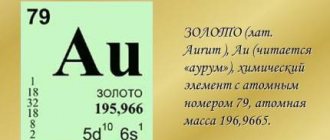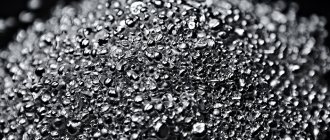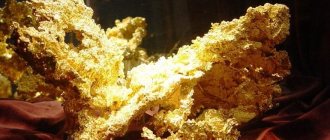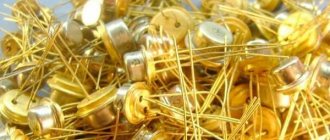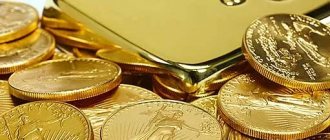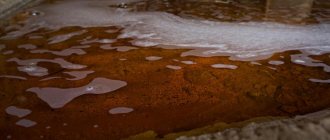Gold on Igor Garshin's website
Home
| Write |
Home > Evolution of nature > Evolution of matter > Atoms > Gold
Alphabetical list of pages: | | | | | E (Yo) | | | | | | | | | | | | | | | | | | | | | | | | 0-9 | AZ (English)
| Atoms are the Lego of nature. |
Gold (lat. Aurum), Au, chemical element of group 1 of the Mendeleev periodic system; atomic number 79, atomic mass 196.9665; a heavy yellow metal classified as noble. Consists of one stable isotope 197Au.
The reviews are given in accordance with the encyclopedic articles by S. A. Pogodin and A. I. Stadnichenko.
Sections of the page about gold as a substance and material :
- Physical and physico-chemical properties of gold
- Chemical properties of gold and its compounds - see also geochemistry of gold
- Gold in nature - see also gold fields and gold-bearing nodes
- Historical background on the use of gold
- Gold recovery - see also gold exploration and mining
- Gold in the noosphere (application)
- Gold in the biosphere and in medicine - see also about the biogenic concentration of gold
- Online reviews about gold
- Network news about gold
- Bibliography on gold
Physical and physico-chemical properties of gold
| GOLD (Aurum) Au, chemical. element I gr. periodic systems, at. n. 79, at. m. 196.9665; refers to noble metals . There is only one stable isotope in nature, 197Au. External configuration electron shell 5d106s1; oxidation states +1, +3, rarely +5; ionization energies of Au0 : Au+ : Au2+ : Au3+ are respectively 9.2258, 20.5 and 30.5 eV; Pauling electronegativity 2.4 electron affinity 2.8 eV; atomic radius 0.144 nm, ionic radii (coordination numbers are indicated in parentheses) Au+ 0.151 nm (6), Au3+ 0.082 nm (4), 0.099 nm (6). 3 gold - yellow metal; crystalline face-centered lattice cubic, a = 0.40786 nm, z = 4, space. Fm3m group. Gold is a soft, very ductile, malleable metal (can be forged into sheets up to 8·10-5 mm thick, drawn into wire, 2 km of which weigh 1 g): Mohs hardness ~ 2.5, Brinell hardness 220-250 MPa ; elastic modulus 81 GPa; srast 10-25 MPa. Gold conducts heat and electricity well. |
- The crystal lattice of gold is face-centered cubic, a = 4.704 A.
- ⚛ Atomic radius 1.44 A, ionic radius Au1+ 1.37 A.
- tmelt 1064.43°C, tkp 2947°C (the value 2880°C is also given); thermal coefficient of linear expansion 14.2·10-6 (0–100°С);
- temperature coefficients linear expansion (5.98-19.10).10-6 K-1 (40-1200 K), volumetric (1.79-5.73).10-5 K-1 (40-1200 K); thermal conductivity 318 W/(m.K) at 273 K; r (2.06-2.84).10-8 Ohm.m (273-373 K), temperature coefficient. r 4.0.10-3 K-1 (273-373 K);
- specific thermal conductivity 311.48 W/(m K) [0.744 cal/cm (sec °C]; specific heat capacity 132.3 J/(kg K) [0.0316 cal/g °C] (at 0° -100°С);
- electrical resistivity 2.25 x 10-8 ohm (m (2.25 x 10-6 ohm (cm)) (at 20°C); temperature coefficient of electrical resistivity 0.00396 (0-100°C).
- С0p 25.39 J/(mol.K); DH0pl 12.55 kJ/mol, DH0sp 348 kJ/mol; S0298 47.40 J/(mol.K);
- level of temperature dependence of vapor pressure: for solid 3. logp (hPa) = 3.94 - 19820/T - 0.3061gT - 0.16.10-3 T (298-1337 T), for liquid logp (Pa) = 10.710 + 17866/T (1337-3150 K);
- diamagnetic, magnetic susceptibility -29.59.10-6.
- The density of solid gold is 19.32 g/cm3 (at 20°C), liquid gold is 17.22 g/cm3 (1100°C);
- Elastic modulus 79·103 MN/m2 (79·102kgf/mm2), for annealed gold tensile strength 100–140 MN/m2 (10–14 kgf/mm2), relative elongation 30–50%, narrowing of cross-sectional area 90% .
- After plastic deformation in the cold, the tensile strength increases to 270–340 Mn/m2 (27–34 kgf/mm2). Brinell hardness 180 MN/m2 (18 kgf/mm2) (for annealed gold about 400 °C).
Gold is very resistant to chemical influences. It is stable in air and water. Does not interact directly with O2, H2, N2, P, Sb and C. Phosphide Au2P3 (DH0arr -102 kJ/mol) and antimonide AuSb2 (DH0arr - 13 kJ/mol) are obtained indirectly.
3 gold does not dissolve in solutions of alkalis and solutions, sol. in hot H2SeO4, mixtures of H2SO4 with HNO3, H2SO4 with HMnO4, as well as in aqua regia (HCl + HNO3): Au + HNO3 + 4HCl: H[AuCl4] + NO + 2H2O; after careful evaporation, yellow crystals of complex chloroauric acid HAuCl4.3H2O are released. In aqueous solutions of cyanides (Na, Ca, K) with access to O2 or other oxidizing agents, gold dissolves. with the formation of dicyanoaurate ion (cyanidation): 2Au + 4CN- + H2O + 0.5O2: 2[Au(CN)2]- + 2OH-, which underlies the most important industrial process. method of extracting gold from ores. Gold does not interact with halogens in the absence of moisture without heating; when heated. gold powder in a halogen atmosphere, gold halides are formed.
Gold forms alloys with many metals. One of the methods for extracting gold from rocks is based on the easy formation of gold amalgam. Conn. gold is unstable, hydrolyzes in aqueous solutions, and is easily reduced to metal.
Chemical properties of gold and its compounds
The configuration of the outer electrons of the gold atom is 5d10 6s1. In compounds, gold has valences of 1 and 3 (complex compounds in which gold is 2-valent are known).
Gold is characterized by its easy reduction from compounds to metal and the ability to form complexes. The existence of gold oxide, i.e. gold oxide (I) Au2O, is doubtful.
Gold does not interact with non-metals (except halogens). With halogens, gold forms halides, for example 2Au + 3Cl2 = 2AuC13. Gold dissolves in a mixture of hydrochloric and nitric acids, forming chlorauric acid H [AuCl4].
In solutions of sodium cyanide NaCN (or potassium KCN), with simultaneous access to oxygen, gold is converted into sodium cyanoaurate (I) 2Na. This reaction, discovered in 1843 by P.R. Bagration, received practical application only at the end of the 19th century. (see Cyanidation).
Gold(I) chloride AuCl is obtained by heating gold(III) chloride: AuC13 = AuCl + C12.
Gold(III) chloride AuC13 is obtained by the action of chlorine on powder or thin leaves of gold at 200 °C. Red needles of AuCl3 give a brown-red solution of complex acid with water: AuC13 +H2O=H2[AuOC13].
When a solution of AuC13 is deposited with caustic alkali, amphoteric yellow-brown gold(III) hydroxide Au(OH)3 with predominant acidic properties precipitates; that's why it's called golden acid
, and its salts -
aurats
(III). When heated, gold (III) hydroxide turns into gold oxide Au2O3, which above 220° decomposes according to the reaction: 2Au2O3 = 4Au + 3O2.
When gold salts are reduced with tin(II) chloride 2AuC13 + 3SnCl2 = 3SnCl4 + 2Au, a very stable purple colloidal solution of gold is formed ( Cassium purple
); this is used in analysis to detect gold. Quantitative determination of gold is based on its precipitation from aqueous solutions with reducing agents (FeSO4, H2SO3, H2C2O4, etc.) or on the use of fire assay.
Au(OH)3 hydroxide - dark brown crystals; when heated, it dehydrates to form first AuO(OH), and then sesquioxide Au2O3, which decomposes into gold and O2 above 160°C; solubility in water is 2.4.10-12 mol/l at 20°C, in HNO3 solutions - up to 0.38 mol/l at 25°C, in NaOH solutions - up to 8.10-4 mol/l at 25°C. In the latter case, gold is present in the solution in the form of hydroxoaurate ions [Au(OH)4]- (pH 7-13). Au(OH)3 is formed by adding a concentrated solution of alkali or Mg(OH)2 to solutions of H[AuCl4].
Auras are unstable and easily decompose when heated. Alkali metal aurates are highly soluble in water, solubility increases with increasing ionic radius of the cation; Mg, Ca, Sr, Ba, Tl(I) aurates have limited solubility. Aurates form explosive mixtures with some organic substances. It is assumed that when gold hydroxide is exposed to alkali solutions, aurate anions [H2AuO3]-, [HAuO3]2-, [AuO3]3- are formed. See also table. 2.
Other oxygen compounds of gold are unstable and easily form explosive mixtures. The compound Au2O3 with ammonia Au2O3.4NH3 is called “explosive gold”; explodes at 145°C, sometimes at lower temperatures; dissolves without explosion in solutions of alkali metal cyanides.
Gold hemisulfide Au2S - black-brown crystals; DG0arr 29 kJ/mol; poorly soluble in water (p-value product 4.10-69 at 25 °C), sol. in solutions of cyanides and polysulfides of alkali metals. Receive interaction. conc. solution K[Au(CN)2] with H2S from the last. heating to boiling with excess hydrochloric acid. Sesquisulfide Au2S3 - black crystals; decomposes when heated. up to 200 °C; not sol. in salt and sulfuric acid, sol. in HNO3 with the release of elemental gold, KCN solutions, bromine water. Receive interaction. H2S with AuCl3 or complex gold chlorides in anhydrous ether in the cold. Complex compounds containing the anions [AuS3]2-, [AuS2]-, [AuS]-, [Au(SO3)2]3-, [Au(S2O3)2]3- are known.
AuSe monoselenide exists in two crystalline forms. modifications of the monoclinic system. When treating gold hydrochloric acid solutions in the cold with hydrogen selenide, sesquiselenide Au2Se3.H2Se is deposited, which is stable (after drying) in the range of 40-390°C; at 535-650°C it decomposes with the release of elemental gold.
Selenate (IV) Au2(SeO3)3.3H2SeO3 lemon-yellow crystals; not sol. in water, sol. in salt and selenium (when heated) compounds.
Selenate (VI) Au2(SeO4)3 yellow crystals; DH0rev - 954 kJ/mol; not sol. in water, decomposes with hydrochloric acid, sol. in H2SO4, HNO3 and hot conc. H2Se04.
Telluride (hemitelluride) AuTe2 - crystals from brass-yellow to silver-white with metallic. shine; dense 9.3 g/cm, DH0rev - 11 kJ/mol; brittle, Mohs hardness 2.5-3.
AuSCN thiocyanate is colorless. crystals; not sol. in water and org. r-retailers; at 140°C decomposes to metallic. gold and (SCN)n; under the influence of water it forms strong complex anions [Au(SCN)2]- and [Au(SCN)4]- in solutions.
Colloidal gold
When restoring gold in the breakdown. solution of its salts, as well as with electric. By spraying gold in water, colloidal solutions of gold are formed, the color of which depends on the degree of dispersion of the particles, and the intensity of the color on their concentration. Gold particles in a colloidal solution are negatively charged. A hydrophobic gold sol in hydrochloric acid aqueous solution can be represented by the following diagram:
[Au]m is the core of the micelle (the number of atoms m, depending on the conditions, can vary from several hundreds to millions of units); AuCl4- - ions that determine the negative charge of the colloidal gold particle and the potential of the adsorption layer of thickness d0; H+ - counterions that determine the potential of the diffusion layer (electrokinetic potential), of which x ions are located in the blurred part of the double layer with thickness d; n is the number of AuCl4- ions adsorbed on the surface of the micelle core, while n
[edit] Links
- Gold in the Absurdopedia on Wikia (humorous article)
Electrochemical activity series of metals
, , , , , , , , , , , , , , , , , , , , , , , , , , , , , , , , , , , , , , , , , , , , , , , , , , , , , , , H2
, , , , , , , , , , , , , , , , ,
Au
| Periodic table of chemical elements by D. I. Mendeleev | |||||||||||||||||||||||||||||||||||||||||||
| Au | |||||||||||||||||||||||||||||||||||||||||||
| Uue | Ubn | Ubu | Ubb | Ubt | Ubq | UBP | Ubh | ||||||||||||||||||||||||||||||||||||
| Alkali metals | Alkaline earth metals | Lanthanides | Actinoids | Superactinoids | Transition metals | Other metals | Semimetals | Other non-metals | Halogens | Noble gases | Properties unknown | ||||||||||||||||||||||||||||||||
Gold in nature
Gold prevalence
The average gold content in the lithosphere (earth's crust) is 4.3·10-7% by mass, in sea and ocean water it is less than 5.10-6 mg/l. Refers to scattered elements. Gold is dispersed in magma and igneous rocks, but hydrothermal gold deposits of important industrial importance (quartz gold-bearing veins, etc.) are formed from hot waters in the earth’s crust. In ores, gold is mainly in a free (native) state and only very rarely forms minerals with selenium, tellurium, antimony, and bismuth. Pyrite and other sulfides often contain an admixture of gold, which is extracted during the processing of copper, polymetallic and other ores.
More than 20 minerals are known, of which the main one is native gold (electrum, copper, palladium, bismuth, etc.), which is a solid solution of silver (from traces to 43%) in gold and also containing Cu, Fe, Pb , less often - platinum group metals, Mn, Bi, etc. Chemical compounds of gold are rare in nature, mainly. these are tellurides - calaverite AuTe2, krennerite (Au,Ag)Te2, sylvanite AuAgTe4, petzite Ag3AuTe2, mutmannite (Ag,Au)Te, montbreuite Au2Te3, etc. 3gold is present Ch. arr. in quartz, carbonates, pyrite, arsenopyrite, galena, sphalerite, chalcopyrite.
Gold in deposits
In ores, gold is present in the form of inclusions of sizes b. h. 0.1-1000 microns, sometimes nuggets up to several are found. tens of kg. The destruction of endogenous gold deposits leads to the formation of gold placers of industrial importance.
Genetic types of industrial gold deposits: hydrothermal high-temperature gold-arsenopyrite formations; hydrothermal medium-temperature quartz-sulfide and gold-quartz formations; hydrothermal low-temperature gold-silver formations; weathered and metamorphosed deposits; alluvial placers.
Gold is extracted from gold ores themselves and, incidentally, from iron, copper, lead-zinc and uranium ores. Gold is mined in 41 countries; its main reserves are concentrated in the USSR, South Africa and Canada. World industrial gold resources (without USSR) approx. 65 thousand tons
Content
- 1 Origin
- 2 Isotopes
- 3 Physical properties
- 4 Chemical properties
- 5 Being in nature
- 6 Gold mining
- 7 Application
- 8 Obtaining gold 8.1 Panning
- 8.2 Amalgamation
- 8.3 Cyanidation
- 8.4 Regeneration
Historical background on the use of gold
Gold was the first metal known to man. Gold items were found in the cultural layers of the Neolithic era (5th-4th millennium BC). In ancient states - Egypt, Mesopotamia, India, China, the mining of gold, the manufacture of jewelry and other items from it existed 3-2 thousand BC. e. Gold is often mentioned in the Bible, the Iliad, the Odyssey and other monuments of ancient literature. Alchemists called gold the “king of metals” and designated it with the symbol of the Sun; the discovery of ways to transform base metals into gold was the main goal of alchemy.
Initially, gold was used exclusively for making jewelry, then it began to serve as a means of saving and accumulating wealth, as well as exchange (first in the form of ingots). Gold was used as money as early as 1500 BC. e. in China, India, Egypt and the states of Mesopotamia, and in Ancient Greece - in the 8th-7th centuries. BC e. In Lydia, rich in gold deposits, in the 7th century. BC e. The minting of the first coins in history began. The name of the Lydian king Croesus (reigned around 560-546 BC) became synonymous with untold wealth. On the territory of the USSR (in Armenia), gold coins were minted in the 1st century. BC e. But in ancient times and in the Middle Ages, gold was not the main currency metal. Along with it, the functions of money were performed by copper and silver.
The pursuit of gold and the passion for enrichment were the reasons for numerous colonial and trade wars; during the era of the Great Geographical Discoveries, they pushed people to search for new lands. The flow of precious metals to Europe after the discovery of America was one of the sources of the initial accumulation of capital. Until the middle of the 16th century. From the New World, mainly gold was imported to Europe (97-100% of the imported metal), and from the 2nd third of the 16th century, after the discovery of the richest deposits of silver in Mexico and Peru - mainly silver (85-99%).
In Russia at the beginning of the 19th century. New gold deposits began to be developed in the Urals and Siberia, and for three decades the country ranked first in the world in its production. In the middle of the 19th century. Rich gold deposits were discovered in the USA (California) and Australia in the 1880s. - in the Transvaal (South Africa). The development of capitalism and the expansion of intercontinental trade increased the demand for monetary metals, and although gold production increased, in all countries, along with gold, silver continued to be widely used as money. At the end of the 19th century. There was a sharp decrease in the cost of silver due to the improvement of methods for its extraction from polymetallic ores. The growth of world gold production and especially the influx of it into Europe and the United States from Australia and Africa accelerated the displacement of depreciated silver and created the conditions for the transition of most countries to monometallism (gold) in its classical form of the gold coin standard (see Gold standard). The first to switch to gold monometallism was at the end of the 18th century. Great Britain. By the beginning of the 20th century. gold currency has established itself in most countries of the world.
- The first gold miners. Ancient mines in southern Egypt date from 5500 to 3100 BC. e. Recognizing the antiquity of the mines, some scientists are inclined to believe that the Mesopotamians took up gold mining before the Egyptians, and the subjects of the pharaohs borrowed the proven technology. This is confirmed by the fact that the mines found are located in an area that was one of the stages of the ancient trade route between Egypt and Mesopotamia.
[edit] Other facts
- In 1947, American physicists Ingram, Hess and Haydn obtained 35 micrograms of gold during an experiment to measure the effective cross section for neutron absorption by mercury nuclei. Gold came out as a by-product. Thus, the long-standing dream of alchemists was realized; mercury was turned into gold. However, this method is not suitable for the industrial production of gold - after all, such gold will be disproportionately more expensive than that obtained even from the poorest ores.
- Theoretically, gold can be obtained by bombarding natural mercury-196 with neutrons. The resulting radioactive mercury-197 turns into gold-197 by beta decay.
- Gold can be drawn into a wire 1 km long, but with a mass of only 2 g.
- In Ancient Rus', gold was abbreviated as “zlat”.
Gold extraction
Sources of gold are sands and ores of placer and primary gold deposits (their gold content is 5-15 g/t), as well as intermediate ones. products (0.5-3 g/t) of lead-zinc, copper, uranium and certain other products. Gold is extracted from placers by gravity. methods using the so-called traps, jigging machines, concentration resins, sluices, decomposition. flushing devices. Gold-bearing sands are mined from the bottom of rivers and lakes and enriched in dredges. When extracting gold from primary ores, a combine is used. schemes including enrichment (gravity, flotation) and metallurgical (leaching, ion-exchange sorption from pulps, cyanidation, less commonly amalgamation) operations. When using cyanidation, the crushed ore or concentrate is treated with NaCN solution with stirring; from cyanide solutions, gold is precipitated with Zn powder, using ion exchange resins or activators. coals. The final products of the scheme are usually gravity concentrate (the so-called gold head) and rough gold. Gold is purified by dissolving it in aqua regia and the afterglow. elect precipitation (for example, using FeSO4), chlorination in a melt or solution (chlorination) and electrolytic. refining in hydrochloric acid solution.
Obtaining gold and refining it. Gold can be extracted from placer deposits by elutriation, based on the large difference in densities of gold and waste rock. This method, which was already used in ancient times, is associated with large losses. It gave way to amalgamation (known already in the 1st century BC and used in America since the 16th century) and cyanidation, which became widespread in America, Africa and Australia in the 1890s. At the end of the 19th - beginning of the 20th centuries. Indigenous deposits became the main source of gold. The gold-bearing rock is first crushed and enriched. Gold is extracted from the resulting concentrate with a solution of potassium or sodium cyanide. Gold is precipitated with zinc from a solution of complex cyanide; At the same time, impurities also fall out. To purify (refin) gold by electrolysis (method of E. Wollwill, 1896), anodes cast from impure gold are suspended in a bath containing a hydrochloric acid solution of AuC13; a sheet of pure gold serves as the cathode. When a current passes, impurities precipitate (anodic sludge, sludge), and gold with a purity of at least 99.99% is deposited on the cathode.
Definition [identification in rocks and minerals]. Gold is detected qualitatively by the formation of colored sediments and solutions. They use connections. gold with Hg2Cl2, H2O2, SnCl2, K4[Fe(CN)6], KI, bsnzidine, 1-naphthylamine, o-toluidine, guaiac resin, complexone III, ascorbic acid, phenylthiourea, dithizone, rhodamine, isoquinoline, etc. You can use sorption on ion-exchange resins, as well as methods of electrophoresis, chromatography (circular thin-layer, precipitation and distribution), and luminescence. Gold is determined quantitatively 1) gravimetrically (in the form of metallic gold), 2) titrimetrically (by the reduction of Au3+ with subsequent titration of the excess reducing agent), 3) photometrically (by the orange color of the bromouraate ion, as well as by the intense color of the compound 3. with decomp. organic reagents), 4) electrochemically, spectral methods, activation methods, atomic absorption. and assay analyses. For pre- Gold concentration uses chemical methods, liquid extraction and chromatography.
Gold in the noosphere (application)
Gold is a currency metal that serves as the universal equivalent of money. Gold and its alloys are used for decorative purposes, the manufacture of jewelry, coins, medals, dentures, parts of chemical equipment, electrical contacts and wires, microelectronics products, for cladding pipes in chemical applications. industry, in the production of solders, catalysts, watches, for coloring glass, making nibs for fountain pens, coating metal. surface (in aircraft construction, space technology and other areas). Art. The radioactive isotope 198Au (T1/2 2.967 days) is used to treat tumors in radiotherapy. World production 3. (without the USSR) approx. 1100 t/year (1984). Basic producers - South Africa, USSR, Canada, USA, Brazil, Australia. Some Au(I) preparations are toxic and accumulate in the kidneys, and, to a lesser extent, in the liver, spleen and hypothalamus; the accumulation of gold in the kidneys can lead to kidney disease, as well as dermatitis, stomatitis, and thrombocytopenia. Gold was known to man already in ancient times; it is possible that it was the first metal that humanity began to use for its needs. There is data on the extraction of gold and the manufacture of various types of gold from it. products in Egypt (4100-3900 BC), India, Indochina (2000-1500 BC), etc.
Gold in technology
In technology, gold is used in the form of alloys with other metals, which increases the strength and hardness of gold and allows it to be saved (see Gold alloys). The gold content in alloys used for the manufacture of jewelry, coins, medals, semi-finished products for dental prosthetic production, etc., is expressed by breakdown (see Sample of precious metals, Jewelry alloys); Usually the additive is copper (the so-called alloy). In an alloy with platinum, gold is used in the production of chemically resistant equipment, in an alloy with platinum and silver - in electrical engineering. Gold compounds are used in photography (tinting).
Gold in economics
In conditions of commodity production, gold performs the function of a universal equivalent (money). Expressing the value of all other goods, gold as a universal equivalent acquires a special use value and becomes money. The commodity world singled out gold as money because it has the best physical and chemical properties for a monetary commodity: homogeneity, divisibility, storability, portability (high value for small volume and weight), and easy to process. A significant amount of gold is used to make coins or in the form of bars is stored as the gold reserve of central banks (states). Gold is widely used for industrial consumption (in radio electronics, instrument making and other advanced industries), as well as as a material for the manufacture of jewelry.
The size of gold reserves is an important indicator of the stability of capitalist currencies and the economic potential of individual countries. The purchase and sale of gold for industrial consumption, as well as for private hoarding (accumulation), is carried out on special gold markets (see Gold Markets). The loss of gold from free interstate market circulation caused a reduction in its share in the monetary system of the capitalist world and, above all, in the foreign exchange reserves of capitalist countries (from 89% in 1913 to 71% in 1928, 69% in 1958 and 55% in 1969). An increasingly significant part of the newly mined gold is supplied for hoarding and industrial use (in the modern chemical industry, for rocketry, space technology). Thus, during 1960–70, private hoarding of gold increased by 3.3 times, its industrial and jewelry use by almost 2.3 times, and the gold reserves of capitalist countries remained at almost the same level ($41 billion).
Gold in art
Gold has been used since ancient times in jewelry (jewelry, religious and palace utensils, etc.), as well as for gilding. Due to its softness, malleability, and ability to stretch, gold lends itself to particularly fine processing by embossing, casting, and engraving. Gold is used to create a variety of decorative effects (from the smooth surface of a yellow polished surface with smooth tints of light highlights to complex textured juxtapositions with a rich play of light and shadow), as well as to create the finest filigree. Gold, often colored with impurities of other metals in various colors, is used in combination with precious and semi-precious stones, pearls, enamel, and niello.
Where can the procedure be performed?
- Gold refining is carried out by specialized enterprises. In Russia, these are Uralelectromed JSC, Kolyma Refinery and several other organizations. The main method of purifying metal from impurities on an industrial scale is electrolytic (separation of the melt into its component parts by passing an electric current through it).
- There are laboratories with the necessary equipment and hood.
- Some refining techniques can be reproduced at home if you take care of the materials and tools.
Gold in the biosphere and in medicine
In the biosphere, gold migrates in combination with organic compounds and mechanically in river suspensions. 1 liter of sea and river water contains about 4·10-9 g of gold. In areas of gold deposits, groundwater contains approximately 10-6 g/l gold. It migrates in soils and from there enters plants; some of them concentrate gold, such as horsetails and corn.
In medicine, gold preparations are used in the form of a suspension in oil (domestic drug Krizanil, foreign - myocrisin) or water-soluble drugs (foreign - Sancrizin and Solganal) for injection in the treatment of chronic rheumatoid arthritis, erythematous lupus erythematosus, often in combination with hormonal and other drugs . Gold preparations often cause side effects (fever, irritation of the intestines, kidneys, etc.). Contraindications to the use of gold preparations: severe forms of tuberculosis, diabetes mellitus, diseases of the cardiovascular system, liver, kidneys, blood. Radioactive gold (usually 198Au) is injected into tissues in the form of pins, granules, etc. - for gamma therapy and in the form of colloidal solutions - for beta therapy. It is used in the treatment of tumors, usually in combination with surgical and drug treatment, as well as for diagnostic purposes - in the form of colloidal solutions in the study of the reticuloendothelial system, liver, spleen and other organs.
[edit] Literature
- Baukova, Tatyana Valentinovna. Gold in chemistry and medicine. - M.: Knowledge, 1991. - 31 p.: ill. — (New in life, science, technology. Chemistry; 8/1991). — ISBN 5-07-002078-1
- Foss, G.V. Gold: types of deposits, production history, raw material bases / G.V. Foss. - Moscow: Gosgeoltekhizdat, 1963. - 174 p.
- Borisov, S. N. Gold in the modern world / S. M. Borisov; RAS, Institute of World Economy and International. relationships. - Moscow: Nauka, 2006. - 248 p.
- Belarusian Encyclopedia: In 18 vols. T. 7 / Editorial Board: G. P. Pashkov and others - Minsk: BelEn, 1999. - 608 p.: ill.
Network news about gold
- Pico-sized gold clusters set catalysis records.
- A completely new form of gold has been created. At very high pressure, gold develops a different structure at the atomic level. The crystal structure of gold is quite stable and resembles an octahedron or cube. Therefore, it is used as a kind of standard in experiments with high pressure. When scientists quickly compressed gold at very high temperatures, it formed what is called a body-centered cubic lattice (BCC), in which the atoms are “packed” less efficiently.
Receipt
Obtained from gold(III) hydroxide Au2O3 x
H2O by dehydration by heating. Complete loss of water occurs at a temperature of about 200 o C. [1]. The gold(III) oxide thus obtained is amorphous. It has a red or red-brown color. The brown impurity, as in the case of gold(III) hydroxide, is usually associated with the presence of a small amount of gold(0). Au2O3 single crystals were obtained from an amorphous oxide by hydrothermal synthesis in a quartz ampoule filled one-third with a mixture of perchloric acid HClO4 and alkali metal perchlorate (synthesis temperature 235-275 o C, pressure up to 30 MPa). The resulting single crystals had a ruby red color [1].

